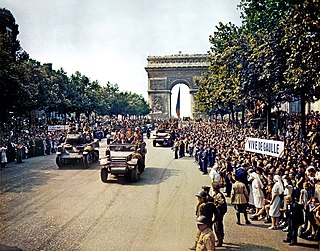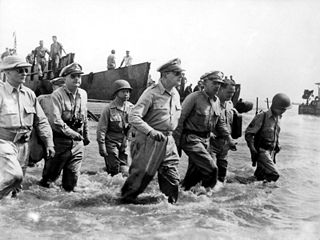A resistance movement is an organized effort by least portion of the civil population of a country to withstand the legally established government or an occupying power and to disrupt civil order and stability. It may seek to achieve its objectives through either the use of nonviolent resistance, or the use of force, whether armed or unarmed. In many cases, as for example in the United States during the American Revolution, or in Norway in the Second World War, a resistance movement may employ both violent and non-violent methods, usually operating under different organizations and acting in different phases or geographical areas within a country.
Combatant is the legal status of an individual who has the right to engage in hostilities during an armed conflict. The legal definition of "combatant" is found at article 43(2) of Additional Protocol I (AP1) to the Geneva Conventions of 1949. It states that "Members of the armed forces of a Party to a conflict are combatants, that is to say, they have the right to participate directly in hostilities." Consequently, on the other hand combatants, as a rule, are legal targets themselves for the opposite side regardless the specific circumstances at hand, in other words, they can be attacked regardless of the specific circumstances simply due to their status, so as to deprive their side of their support.

The 43rd Philippine Scout Infantry Regiment was part of USAFFE's Philippine Division, during World War II.

In Albania, World War II began with its invasion by Italy in April 1939. Fascist Italy set up Albania as its protectorate or puppet state. The resistance was largely carried out by Communist groups against the Italian and then German occupation in Albania. At first independent, the Communist groups united in the beginning of 1942, which ultimately led to the successful liberation of the country in 1944.

The 8th Armored Division was an armored division of the United States Army that served in the European Theater of World War II.

The Argentine War of Independence was fought from 1810 to 1818 by Argentine patriotic forces under Manuel Belgrano, Juan José Castelli and José de San Martín against royalist forces loyal to the Spanish crown. On July 9, 1816, an assembly met in San Miguel de Tucumán, declared full independence with provisions for a national constitution.

The liberation of Paris was a military battle that took place during World War II from 19 August 1944 until the German garrison surrendered the French capital on 25 August 1944. Paris had been occupied by Nazi Germany since the signing of the Second Compiègne Armistice on 22 June 1940, after which the Wehrmacht occupied northern and western France.

The Ruhr pocket was a battle of encirclement that took place in April 1945, on the Western Front near the end of the second World War, in the Ruhr Area of Germany. Some 317,000 German troops were taken prisoner along with 24 generals. The Americans suffered 10,000 casualties including 2,000 killed or missing.
The Netherlands entered World War II on May 10, 1940, when invading German forces quickly overran the country. On December 7, 1941, after the attack on Pearl Harbor, the Netherlands government in exile also declared war on Japan. Operation Market Garden, which started in 1944, liberated the southern and eastern parts of the country, but full liberation did not come until the surrender of Germany on May 5, 1945.

Surrender, in military terms, is the relinquishment of control over territory, combatants, fortifications, ships or armament to another power. A surrender may be accomplished peacefully or it may be the result of defeat in battle. A sovereign state may surrender following defeat in a war, usually by signing a peace treaty or capitulation agreement. A battlefield surrender, either by individuals or when ordered by officers, normally results in those surrendering becoming prisoners of war.
The Orphan Brigade was the nickname of the First Kentucky Brigade, a group of military units recruited from Kentucky to fight for the Confederate States of America during the American Civil War. The brigade was the largest Confederate unit to be recruited from Kentucky during the war. Its original commander was John C. Breckinridge, former United States Vice President and candidate for president, who was enormously popular with Kentuckians.

The Philippines campaign, Battle of the Philippines or the Liberation of the Philippines, codenamed Operation Musketeer I, II, and III, was the American, Mexican, Australian and Filipino campaign to defeat and expel the Imperial Japanese forces occupying the Philippines during World War II. The Japanese Army overran all of the Philippines during the first half of 1942. The liberation of the Philippines commenced with amphibious landings on the eastern Philippine island of Leyte on October 20, 1944. The United States and Philippine Commonwealth military forces were progressing in liberating territory and islands when the Japanese forces in the Philippines were ordered to surrender by Tokyo on August 15, 1945, after the dropping of the atomic bombs on mainland Japan and the Soviet invasion of Manchuria.
Wilson's Raid was a cavalry operation through Alabama and Georgia in March–April 1865, late in the American Civil War. Brig. Gen. James H. Wilson led his Union Army Cavalry Corps to destroy Southern manufacturing facilities and was opposed unsuccessfully by a much smaller force under Confederate Lt. Gen. Nathan Bedford Forrest.

The Pacification of Manchukuo was a Japanese counterinsurgency campaign to suppress any armed resistance to the newly established puppet state of Manchukuo from various anti-Japanese volunteer armies in occupied Manchuria and later the Communist Northeast Anti-Japanese United Army. The operations were carried out by the Imperial Japanese Kwantung Army and the collaborationist forces of the Manchukuo government from March 1932 until 1942, and resulted in a Japanese victory.
A victor gives no quarter when the victor shows no clemency or mercy and refuses to spare the life in return for the surrender at discretion of a vanquished opponent. It is against modern international humanitarian law to declare that no quarter will be given.

The Japanese occupation of the Philippines occurred between 1942 and 1945, when Imperial Japan occupied the Commonwealth of the Philippines during World War II.
This is a timeline of the events that stretched over the period of World War II from January 1945 to 1991, its conclusion and legal aftermath.

The German invasion of Denmark, sometimes known as the Six Hour War due to the short length, was the German attack on Denmark on 9 April 1940, during the Second World War. The attack was a prelude to the invasion of Norway.

Operation Achse, originally called Operation Alaric, was the codename for the German operation to forcibly disarm the Italian armed forces after Italy's armistice with the Allies on 3 September 1943. The Germans disarmed over a million Italian troops within a matter of days, annihilating the Italian military and state.

During the Japanese occupation of the islands in World War II, there was an extensive Philippine resistance movement, which opposed the Japanese and their collaborators with active underground and guerrilla activity that increased over the years. Fighting the guerrillas – apart from the Japanese regular forces – were a Japanese-formed Bureau of Constabulary, the Kenpeitai, and the Makapili. Postwar studies estimate that around 260,000 people were organized under guerrilla groups and that members of anti-Japanese underground organizations were more numerous. Such was their effectiveness that by the end of World War II, Japan controlled only twelve of the forty-eight provinces.












